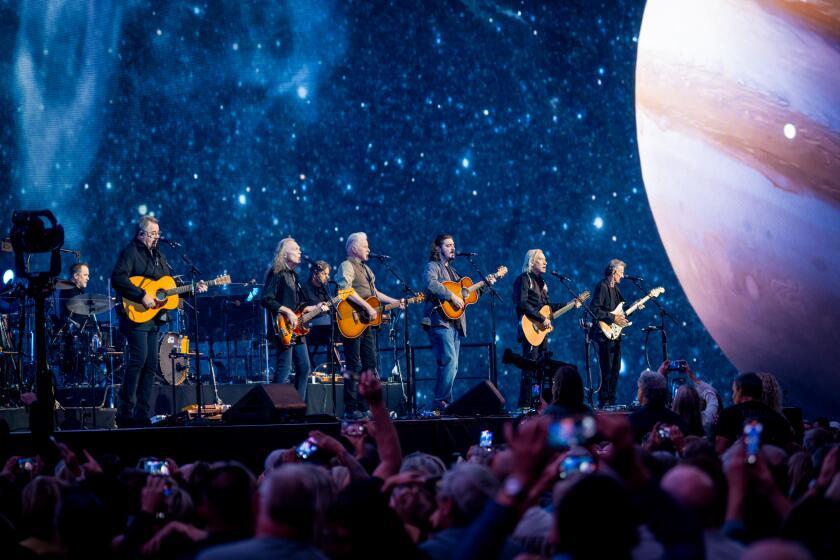JAZZ REVIEW : Holman’s Notes Are Brief but Entertaining
NEWPORT BEACH — If bandleader Bill Holman were looking for a catchy phrase to describe his large ensemble’s offerings, he might consider “Rhythm With an Edge.”
The Orange County native--who has long resided in Hollywood and is regarded by many peers, fans and critics as the nonpareil big band composer-arranger of the day--delivered an individuated rhythmic extravaganza Friday when his band performed in the cool climes of the outdoor amphitheater at the Hyatt Newporter.
Holman’s philosophy for concocting large ensemble charts has long centered on making the band seem smaller, more like a quintet than a 17-member entourage, and one way he does this is by utilizing brief, punchy rhythms. These are the kinds of four-, five-, six-, seven-note ideas that improvisers build their solos on, or that drummers use to fill behind a soloist. Holman often bases his numbers around such figures, and he colors his works by devising short fragments and having his musicians play them at the most surprising moments.
Take Friday’s opener, “No Joy in Mudville,” which Holman jokingly said he wrote for the Southern California baseball teams. The piece began with a solo by valve trombonist Bob Enevoldsen, who played fluidly and with snap, as a four-note line that might have induced finger-popping was extensively repeated by the saxes.
This section came to a sudden stop, as bassist Bruce Lett, the trombones and drummer Bob Leatherbarrow established another four-note repeated vamp, and on top of this trumpets and saxes played brisk passages. Then this shifted to a much slower tempo, as the saxes offered a theme that sounded plain mournful. Later, after more solos and passages that came whizzing in out of left field, the number ended the way it started, with Enevoldsen soloing until the final note, which he delivered with a resounding low tone.
Writing of this manner can be decidedly complex, and Holman can sometimes be a tough nut for a listener to crack. But close aural scrutiny reveals that the essential drive and swing of jazz, if not front and center, is never far from the ear in one of Holman’s pieces.
While Holman has rarely written anything in a funk or R&B; groove, at least for his band, Thelonious Monk and Denzil Best’s “Bemsha Swing” comes close.
This early ‘50s classic, which Monk recorded on the “Brilliant Corners” 1956 Riverside Records album, has a two-note figure that sweeps upward, the way one’s voice rises in the greeting of a friend. Then the melody descends in a tumble-down fashion. Holman gave the lead line to the alto saxophonist Joe Romano and trumpeter Ron Stout, and let bass trombonist Kenny Shroyer add accents, which resembled drummer Max Roach’s timpani effects on the Riverside recording.
Holman underpinned this already rhythmically charged melody with an invigorating shuffle beat that recalled the happy buoyancy of the feel that’s called the “New Orleans Second Line.” The piece included solos by pianist Rich Eames, whose choppy, chordal playing was a delight, and Stout, who went from dark, low tones to bright, high ones, as if he’d walked into a closet and turned on the light.
“Sweet Spot” started slow, and stayed slow, but it was still rhythmically energized. Fluegelhornist Carl Saunders delivered flurries of soft, tender notes while the ensemble offered glowing, swaying figures beneath him. It was like watching the glory of a full moon from a yacht that turns this way and that as it sits, moored in a marina.
Holman’s rhythm-minded affair, the second half of which was taped and can be heard Thursday from 8 to 9 p.m., on KLON-FM (88.1) included several standards--”Georgia on My Mind” and Sonny Rollins’ “St. Thomas” among them--and concluded with a brazen version of “The Tennessee Waltz.”
The concert was dedicated to Bob Cooper, the magnificent tenor saxophonist who had been a regular in Holman’s band since the ‘70s. He died Aug. 6 of a heart attack.
More to Read
The biggest entertainment stories
Get our big stories about Hollywood, film, television, music, arts, culture and more right in your inbox as soon as they publish.
You may occasionally receive promotional content from the Los Angeles Times.









